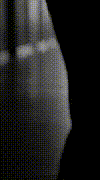chrisheaven
Level of Lemon Feather
- Joined
- Aug 20, 2001
- Messages
- 12,381
- Points
- 0
post some obscure facts.
Traditionally, Japanese is written in a format called 縦書き tategaki, or vertical writing. In this format, the characters are written in columns going from top to bottom. The columns are ordered from right to left, so at the bottom of each column the reader returns to the top of the next column on the left of the preceding one. This copies the column order of Chinese.
Modern Japanese also uses another writing format, called 横書き yokogaki, or horizontal writing. This writing format is identical to that of European languages such as English, with characters arranged in rows which are read from left to right, with successive rows going downwards.
There are no set rules for when each form has to be used, but usage tends to depend on the medium, genre, and subject. Tategaki is generally used to write essays, novels, poetry, newspapers, comics, and Japanese dictionaries. Yokogaki is generally used to write e-mails, how-to books, and scientific and mathematical writing (mathematical formulas are read from left to right, as in English).
Materials written in tategaki are bound on the right, with the reader reading from right to left and thus turning the pages from left to right to progress through the material. Materials written with yokogaki are bound on the left and the pages are turned from right to left, as in English
Traditionally, Japanese is written in a format called 縦書き tategaki, or vertical writing. In this format, the characters are written in columns going from top to bottom. The columns are ordered from right to left, so at the bottom of each column the reader returns to the top of the next column on the left of the preceding one. This copies the column order of Chinese.
Modern Japanese also uses another writing format, called 横書き yokogaki, or horizontal writing. This writing format is identical to that of European languages such as English, with characters arranged in rows which are read from left to right, with successive rows going downwards.
There are no set rules for when each form has to be used, but usage tends to depend on the medium, genre, and subject. Tategaki is generally used to write essays, novels, poetry, newspapers, comics, and Japanese dictionaries. Yokogaki is generally used to write e-mails, how-to books, and scientific and mathematical writing (mathematical formulas are read from left to right, as in English).
Materials written in tategaki are bound on the right, with the reader reading from right to left and thus turning the pages from left to right to progress through the material. Materials written with yokogaki are bound on the left and the pages are turned from right to left, as in English





